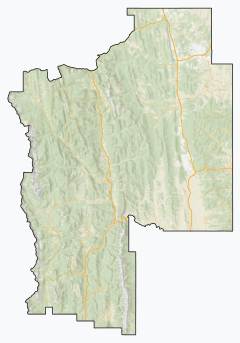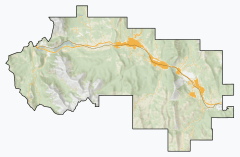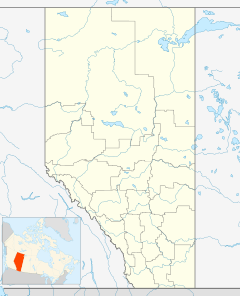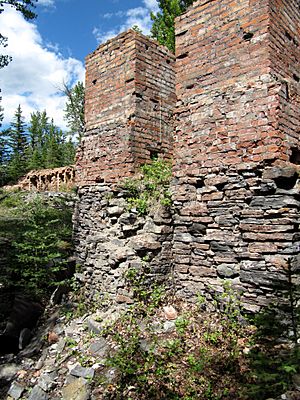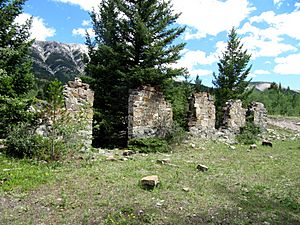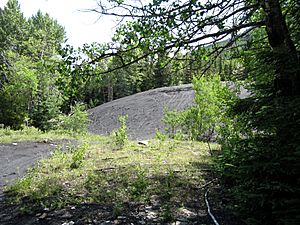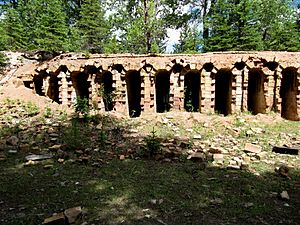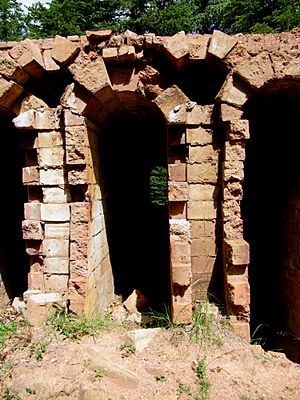Lille, Alberta facts for kids
Quick facts for kids
Lille
French Camp
|
|
|---|---|
|
Former village
|
|
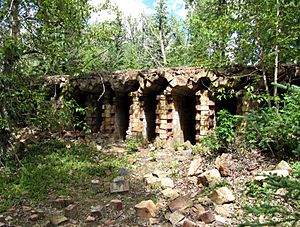
Ruins of coke ovens at the abandoned Lille townsite
|
|
| Country | Canada |
| Province | Alberta |
| Municipal district | Ranchland No. 66 |
| Village | February 22, 1904 |
| Dissolved | 1919 |
| Government | |
| • Type | Unincorporated |
| Time zone | UTC−7 (MST) |
| • Summer (DST) | UTC−6 (MDT) |
Lille is a fascinating ghost town and former village located in the Crowsnest Pass area of southwest Alberta, Canada. It was once a busy community built by a company for its coal miners. Between 1901 and 1912, Lille was home to over 400 people. The coal mines in Lille eventually closed in 1912. This happened mainly because coal prices were low, it cost more to dig for coal, and the coal itself was becoming lower quality. After the mines closed, most of the buildings were taken apart and moved to other places. Today, Lille is an Alberta Provincial Historic Resource. It is famous for the beautiful ruins of its special coke ovens, which were brought all the way from Belgium.
Contents
The Story of Lille
| Population history of Lille |
||
|---|---|---|
| Year | Pop. | ±% |
| 1901 | 3 | — |
| 1906 | 413 | +13666.7% |
| 1911 | 303 | −26.6% |
| 1916 | 0 | −100.0% |
| Source: Statistics Canada | ||
Lille began as a coal mining town in 1901. It was started by two people from a French company called United Gold Fields Ltd. This company later became Western Canadian Collieries in 1903. The company representatives, J. J. Fleutot and C. Remy, were exploring the Crowsnest Pass area when they found a good spot for coal mining.
How Lille Got Its Name
At first, the community was called 'French Camp'. But it was soon renamed Lille. This new name came from a French town where the people who funded the mining project lived. Lille officially became a village on February 22, 1904.
Life in the Mining Town
Most of Lille was built by the mining company itself. It was quite modern for its time, with electricity and a water system. By 1906, the town had grown to 413 people and included about 80 buildings.
These buildings included homes for the miners, a large house for the superintendent, and a doctor's house. There was also a 15-bed hospital, a four-room school, a post office, and a North-West Mounted Police station. For the mining operations, there was a coal washery, a mine stable for horses, and 50 special coke ovens.
The town also had several businesses to serve the community. These included a hotel, a general store, a bakery, a butcher shop, barber shops, and a liquor store.
Mining and Transport
Miners in Lille dug for a type of coal called bituminous coal. They used underground methods to get the coal from deep within the earth. Over the 11 years the community was active, they produced about 901,000 metric tons of coal.
To move the coal and coke from Lille, the company built a special railway line. It was called the Frank and Grassy Mountain Railway. This line connected Lille to the main Canadian Pacific Railway at Frank. The railway was about 11 kilometers (7 miles) long and was very expensive to build. It needed 23 trestle bridges to cross the difficult, steep valley of Gold Creek.
Challenges and Closure
The Frank Slide in 1903 caused a big problem for the company. This massive rockslide destroyed the southern part of the railway line, including many of its bridges. Mining had to stop while the railway was rebuilt. Because of this, the coke ovens that were planned for Frank were instead built at Lille. These ovens, used to turn fine coal into coke, were imported from Belgium. Each brick was numbered to make them easier to put together!
The company faced other difficulties too. A forest fire destroyed railway bridges, and clearing snow from the tracks was a constant struggle. There were also disagreements with workers, low coal prices, rising costs to operate the mines, and the coal itself became less pure. Because of all these problems, the mines at Lille closed in 1912. Most of the buildings and equipment were then taken apart and moved away. By 1916, no one lived in Lille anymore, and the village was officially dissolved in 1919.
Lille Today
Even though Lille was named an Alberta Provincial Historic Resource in 1978, many parts of the townsite have been taken apart over the years. The most interesting part to see today are the beautiful ruins of the Belgian coke ovens. You can still see the numbers on many of the bricks that helped put the ovens together long ago.
You can reach the site by hiking about 6.3 kilometers (3.9 miles) from a parking area near the Frank Slide Interpretive Centre. Another way is a 7-kilometer (4.3-mile) hike from a parking area on the Grassy Mountain Road, starting from Blairmore.


